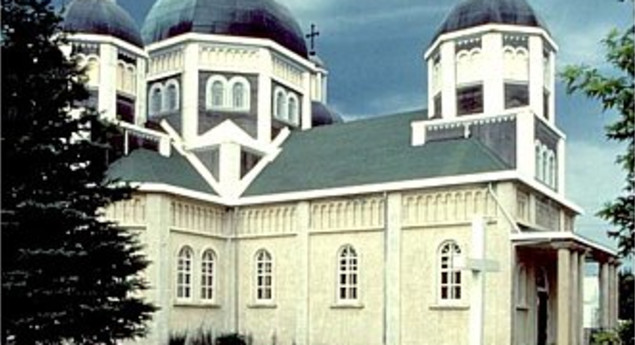DESCRIPTION OF HISTORIC PLACE
The multi-domed Historic Ukrainian Catholic Church of the Resurrection, a stucco-finished structure built in 1936-39, can be seen shaping Dauphin's skyline for several kilometres. Now used on special occasions, the building is set on a corner lot near a 1990 church and parish hall in a quiet residential neighbourhood. The provincial designation applies to the church, metal bell tower and the large lot they occupy.
HERITAGE VALUE
The Historic Ukrainian Catholic Church of the Resurrection, a large structure with a dramatic roofline and spectacular interior iconography, is an ambitious example of the cathedral-style churches built by Ukrainian congregations in Manitoba in the 1920s to 1940s. The church's design showcases the distinctive ways in which its architect, Father Philip Ruh, integrated Byzantine, European and Ukrainian Baroque architectural elements to produce elaborate buildings replete with religious symbolism. For more than four decades, Ruh was instrumental in the development of Ukrainian Catholic churches in Canada. His Dauphin structure is noted for its overall proportions, cruciform plan, complex hipped roofs topped by five substantial domes and visually rich interior painted by Canadian iconographer Theodore Baran. Built by volunteers during the Great Depression of the 1930s, the church served the needs of Dauphin-area Ukrainians for over five decades.
Source: Manitoba Heritage Council Minutes, June 22, 1984
CHARACTER-DEFINING ELEMENTS
Key elements that define the site character of the landmark Historic Ukrainian Catholic Church of the Resurrection include:
- the structure's placement on manicured grounds at the southeast corner of 1st Street SW and 11th Avenue SW in Dauphin, on a longitudinal east-west axis, and utilitarian metal bell tower at the southwest corner
Key elements that define the church's eclectic exterior style and cathedral-like grandeur include:
- the substantial 1 1/2-storey-plus form, based on a cruciform plan, including an elongated narthex and nave, apsidal transepts and sanctuary and adjoining sacristies
- the moderately pitched hip roofs over the main volumes, surmounted by five domes, the largest situated over the crossing and the others over the narthex, sanctuary and transepts; all set on high polygonal drums, lit by multiple openings and topped by cupolas bearing Latin crosses
- the visually striking exterior colour palette, including a lightly tinted stucco finish, darker roofing and domes distinguished by copper sheathing and sharply-contrasting, painted faux-stone elements
- Romanesque-inspired features such as the repetitive use of round-arched openings, including many windows set in pairs and trios; blind arcade detailing beneath the main eaves and on the drums; decorative motifs on the cupolas; etc.
- Neo-Classical elements such as the elevated front portico with Tuscan-style columns, a large fanlight over the double entrance doors, pilasters that prominently divide the elevations into bays, etc.
- the basic construction materials, including cement block walls and concrete foundation
Key elements that define the heritage character of the church's resplendent interior include:
- the logical inner order of the voluminous spaces expressed through the narthex (front vestibule), nave with a wide centre aisle, side transepts, raised sanctuary and high groin-vaulted ceiling
- the large polygonal dome over the crossing, its elaborate detailing and depictions of the heavenly world illuminated by coloured-glass windows
- the elevated sanctuary and apse wall in the east end, painted and ornamented with religious symbolism
- the west-end choir/cantor's balcony, accessed by a staircase off the narthex and extended in a semicircle over the nave with the support of two square piers
- the design elements carried through from the exterior, including smooth plaster walls articulated by faux marble pilasters, semicircular arcades with thick piers to demarcate small spaces from the nave, etc.
- the extensive symbolic decoration, including over the side altars icons dedicated to the Blessed Virgin and Jesus Christ, over the sanctuary the icon of God the Father and throughout the interior, many rendered floral motifs, borders, etc.
- fine features such as the coloured-glass windows, wood flooring, an elegant crystal chandelier suspended from the ceiling of the main dome, etc.
- religious furnishings and articles such as the highly decorated main and side altars, tetrapod and table of oblation, the wooden pews, banners, processional crosses, etc.
Earn 10 points!
Photo: https://www.gov.mb.ca/chc/hrb/prov/p086.html










